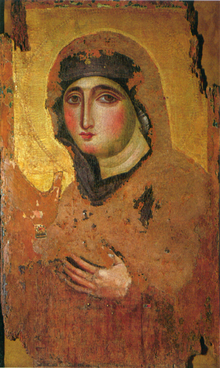Mariya, umama kaYesu
UMariya [lower-alpha 2] wayengumfazi ongumYuda waseNazarete ngenkulungwane yokuqala, [1] umfazi kaYosefu nomama kaYesu . Ungoyena mntu uphambili kubuKristu, uhlonelwa phantsi kwezihloko ezahlukeneyo ezifana nentombi enyulu okanye ukumkanikazi, uninzi lwazo olukhankanywe kwiLitany yaseLoreto . AmaOthodoki aseMpuma naseMpuma, iCawa yaseMpuma, yamaKatolika, yamaTshetshi namaLuthere akholelwa ukuba uMariya, unina kaYesu, nguMama kaThixo .
| Mary | |
|---|---|

|
|
| Born | Template:Circa[lower-alpha 1] Herodian Judea |
| Died | After Template:C. Jerusalem, Province of Judaea, Roman Empire or Ephesus, Province of Asia, Roman Empire[4][5] |
| Spouse(s) | Joseph |
| Children | Jesus |
| Parents | Joachim and Anne (according to some apocryphal writings) |
- ↑ Cite error: Invalid
<ref>tag; no text was provided for refs namedNewAdvent - ↑ Meier, John P. (1991) A Marginal Jew: The Roots of the Problem and the Person Yale University Press p. 407 ISBN 978-0-300-14018-7
- ↑ Sanders, E. P. (1993) The Historical Figure of Jesus Allen Lane Penguin Press pp. 10–11 ISBN 978-0-14-192822-7 archived from the original on 18 April 2017 retrieved 1 September 2022 Unknown parameter
|url-status=ignored (help) - ↑ "Catholic Enncyclopedia: Tomb of the Blessed Virgin Mary" New Advent retrieved 2 January 2023
- ↑ "Tomb of Mary: Location and Significance: University of Dayton, Ohio" udayton.edu retrieved 2 January 2023
Iincwadi zeVangeli ezishwankathelayo zithi uMariya ngumama kaYesu. Incwadi yevangeli kaMateyu nekaLuka zichaza uMariya njengentombi enyulu [lower-alpha 3] eyanyulwa nguThixo ukuba akhawule uYesu ngoMoya Oyingcwele . Emva kokuzala uYesu eBhetelehem, wamkhulisela kwisixeko saseNazarete eGalili, kwaye wayeseYerusalem ekubethelweni kwakhe emnqamlezweni kunye nabapostile emva kokunyuka kwakhe.
Iindlela ezininzi zokuzinikela kukaMarian zibandakanya imithandazo eyahlukahlukeneyo kunye namaculo, ukubhiyozelwa kweentsuku ezininzi zemibhiyozo kaMarian kwinkonzo yonqulo, ukuhlonelwa kwemifanekiso kunye nezinto ezingcwele, ukwakhiwa kweecawe ezinikelwe kuye kunye nokuhambela kwiindawo ezingcwele zaseMarian . Imibono emininzi yaseMarian kunye nemimangaliso ebangelwa kukuthethelelwa kwakhe kuye kwachazwa ngamakholwa ukutyhubela iinkulungwane. Ube sisifundo semveli kubugcisa, ngakumbi kubugcisa baseByzantine, ubugcisa bexesha eliphakathi kunye nobugcisa beRenaissance .
- ↑ Per the Jewish customs surrounding marriage at the time, and the apocryphal Gospel of James, Mary was approximately 13–14 years old when giving birth to Jesus.[1] Her year of birth is therefore contingent on that of Jesus, and though some posit slightly different dates (such as Meier's dating of Template:C. or 6 BC)[2] general consensus places Jesus' birth in Template:C. BC,[3] thus placing Mary's birth in Template:C. BC.
- ↑ Template:Lang-he; Template:Lang-syc; IsiArabhu: مريم; Template:Lang-grc; Template:Lang-la; Template:Lang-cop
- ↑ παρθένος; Matthew 1:23[2] uses the Greek Template:Transliteration, "virgin", whereas only the Hebrew of Isaiah 7:14,[3] from which the New Testament ostensibly quotes, as Template:Transliteration – "young maiden". See article on Template:Transliteration in Bauercc/(Arndt)/Gingrich/Danker, A Greek-English Lexicon of the New Testament and Other Early Christian Literature.[4]
- ↑ Raymond Edward Brown; Joseph A. Fitzmyer; Karl Paul Donfried (1978) Mary in the New Testament NJ: Paulist Press p. 140 ISBN 978-0809121687 archived from the original on 17 August 2021 retrieved 23 February 2021 "...consonant with Mary's Jewish background" Unknown parameter
|url-status=ignored (help) - ↑ Template:Bibleverse
- ↑ Template:Bibleverse
- ↑ Bauercc/(Arndt)/Gingrich/Danker, A Greek-English Lexicon of the New Testament and Other Early Christian Literature, 2nd ed., University of Chicago Press, 1979, p. 627.